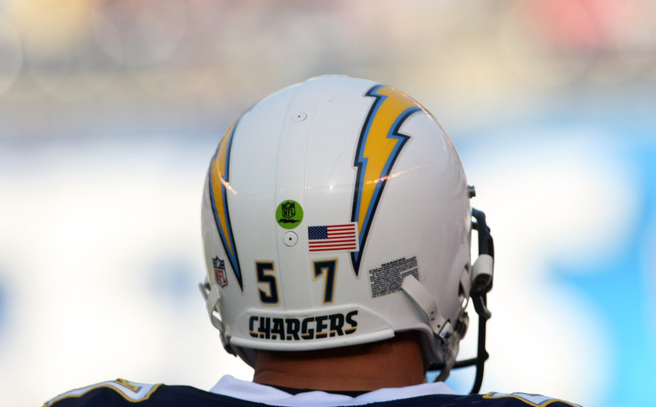As technology continues to develop, we’re starting to see coaches communicate directly with their players by using speakers and microphones.
Only professional football players are allowed speakers in their helmets. Only one player on offense and one on defense are allowed to have speakers. Football players are not allowed to have microphones in their helmets to talk to the coaches.
In this article, we’re going to look at how coaches are using the speaker in the football players’ helmets to gain an advantage.
Do Football Players Have Speakers In Their Helmets?
Football players do not have microphones in their helmets. However, some players do have speakers in their helmets to hear what the coach is saying.
In youth, high school, and college, it is illegal for the coach to talk directly to the quarterback using a microphone/speaker.
This is why the college teams use picture boards and hand signals to call plays, as loud, crazy fan environments make the ability to hear almost impossible.
Currently, the NFL (or professional leagues) are the only ones that use communication technology. The speaker is a small little device placed in the quarterback’s helmet, allowing them to hear the coach.
Here is a great video made by Sports Nation which details a timeline of when the audio speaker was first implemented into the helmet.
Do All Football Players Have Speakers In Their Helmets?
No, all players do not have speakers in their helmets.
This is very important to understand. There are a set of rules the NFL has established with the headset communication:
- Only one player on offense and one player on defense can have a speaker in their helmet. This is a one-way audio device. Meaning the player can not talk back to the coach, he can only hear what the coach is saying.
- The communication shuts off with 15 seconds left on the play clock. This is for the sole purpose of the coach not yelling in the quarterback’s ear before the play to check an audible or essentially mentally playing the game for the quarterback.
- All players who have access to communication must wear a green dot on the back of their helmet seen in the picture below. This is for the referees to identify and check with each player to ensure they are the only ones communicating with the coach

Can Any Coach Talk To The Quarterback Or Defensive Player?
No, the coach talking to the player must be a sidelined coach – meaning the coach in the booth cannot communicate with any player on the field through a speaker in a helmet.
This is for, as mentioned above, the coach not mentally playing the game for the quarterback as the coach will have a perfect birds-eye view of the game.
Only a coach on the sideline can have direct access to one player on the field.
In the NFL, the speaker in the quarterback or the defensive player’s ear will shut off with 15 seconds left on the clock.
This is because the NFL doesn’t want the coaches to be talking to the players the entire play. They are only allowed to talk to the player once the play ends and the new play clock begins.
However, the new XFL tried out consistent communication with having the speakers live at all times for the quarterback, and it seemed to pan out well.
It’ll be interesting to see how the teams in the future can use the headset communication if the rules are altered as the NFL had them.
See Our Complete List Of Helpful Football Articles Here
Technical Issue With The Speaker In The Helmet
By rule, if one side’s communication goes down, the other team must stop using their communication.
This rule was put in to level the playing field, so one team doesn’t have an advantage over the other.
If this happens, teams are usually prepared to have a backup system in place of either using hand signals, having an offensive player run in the play, or, worst case, having the quarterback go to the sideline to get the play from the coach.
In the famous game against Bill Walsh’s San Francisco 49ers and Bill Parcels’ New York Giants, the communication happen to cut between the headsets, which forced both teams to work with no headsets.
Parcels insisted that Walsh did this on purpose, as the New York Giants were crushed.
This is just a small piece of technology that is helping to revolutionize the game of football!
How Important Is Headset Communication
Between the quarterback and the coach, it’s essential. Remember, professional stadiums are often filled with 40,000+ screaming fans. The communication process needs to be clear and efficient for a quarterback to hear his coach.
If the speaker has static or the player cannot hear the coach, the communication process will be broken down. We’ll often see a delay of game or some penalty come from poor communication.
There have also been rumors that the head coach of the LA Rams, Sean McVay, likes to get his play to his quarterback early; that way, he can help dissect the play while still being able to talk to the quarterback.
This tactic is seen being used more and more for young quarterbacks who have a hard time breaking down coverages in the NFL.
Defensive players also rely on coach communication to get the play into the defensive players.
Where it differs, defensive coaches can use simple signals for their players, which can easily convert into coverage and fronts. It’s a little harder for the offense to convert lengthy play calls into one or two-word signals.
If you’ve ever heard an NFL play call, you’d understand what we’re talking about as far as the length of verbiage.
Each coach has their own system of play calling that can either be simplified or require a speaker in the helmet for communication.
Conclusion
Only one player on offense and one player on defense is allowed to have headsets in their helmets. Football players are not allowed to have speakers in their helmets, and the only communication is from coach to player.
Football players must either run to the sideline or hand signal the play to have effective communication.
